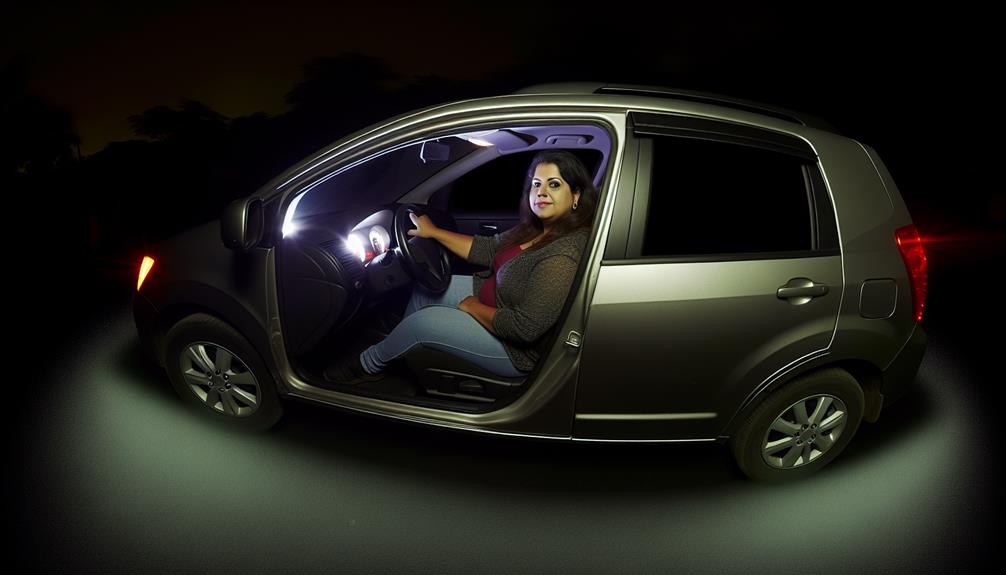The question of whether it is safe to sleep in a car while it's running outside raises crucial considerations regarding personal safety and legal implications. While the convenience of using the car for rest may seem appealing, the potential risks associated with this practice are significant.
Understanding the implications, both from a safety and legal standpoint, is essential before making a decision. Additionally, exploring alternative solutions and implementing safety measures can help mitigate any potential dangers.
Let's explore this topic further to understand the complexities involved in this scenario.
Key Takeaways
- Sleeping in a running car poses risks like carbon monoxide exposure.
- Ensure proper ventilation and check for engine overheating.
- Consider legal regulations on idling engines and emissions.
- Explore alternatives like battery-powered ventilation for safety and comfort.
Risks of Sleeping in a Running Car
Sleeping in a running car poses significant risks to one's safety and health due to the potential for carbon monoxide exposure and other dangers associated with prolonged exposure to vehicle emissions. Carbon monoxide is a colorless, odorless gas produced by the combustion of gasoline in the engine. When a car is left running in a closed space, such as a garage or even outdoors with the windows closed, there is a high risk of carbon monoxide buildup. This can lead to symptoms like dizziness, nausea, headaches, and in severe cases, even death.
Moreover, leaving the engine running while the car is stationary can also lead to engine overheating. The engine produces a significant amount of heat while running, and if the car is not in motion to allow air to cool the engine, overheating can occur. This can result in damage to the engine components and potentially lead to a breakdown, leaving the individual stranded in an unsafe situation. It is crucial to understand these risks and avoid sleeping in a running car to ensure one's safety and well-being.
Safety Precautions to Consider
To ensure personal safety and mitigate potential risks associated with sleeping in a running car, it is imperative to adhere to a set of carefully considered safety precautions.
One of the primary hazards to be aware of is carbon monoxide poisoning. Carbon monoxide is a colorless, odorless gas that can be produced by running a car engine in an enclosed space. To prevent this, it is crucial to ensure proper ventilation inside the vehicle. Before settling in for sleep, crack open the windows slightly to allow fresh air to circulate and reduce the concentration of carbon monoxide. Additionally, consider utilizing ventilation options such as the car's built-in air vents or sunroof if available.
Furthermore, it is advisable to periodically check that the exhaust pipe is not blocked to prevent the buildup of harmful gases inside the car. Regularly inspecting the exhaust system for any leaks or damage can also help minimize the risk of carbon monoxide exposure. By following these safety precautions and staying vigilant, individuals can better protect themselves while sleeping in a running car.
Legal Aspects and Regulations
Compliance with legal regulations and standards regarding the operation and occupancy of vehicles while stationary is essential for ensuring both personal safety and adherence to the law. In many jurisdictions, there are specific parking regulations that dictate where and for how long you can park your car. Some areas prohibit overnight parking in certain locations, especially if the engine is running, to prevent noise disturbances and potential safety hazards. It is crucial to be aware of these regulations to avoid fines or penalties.
Running a vehicle while stationary raises concerns about vehicle emissions. Idling engines can contribute to air pollution by releasing harmful pollutants into the atmosphere. Many regions have strict laws regarding vehicle emissions, aiming to reduce environmental impacts and protect public health. Before deciding to sleep in a running car, it is vital to consider the environmental implications and ensure compliance with emissions standards to minimize the negative effects on air quality.
Alternatives to Sleeping With Engine Running
Exploring alternative methods for rest in a parked vehicle without engine operation is crucial for minimizing environmental impact and ensuring compliance with legal regulations. Vehicle ventilation plays a vital role in creating a safe and comfortable sleep environment. One option is utilizing standalone battery-powered ventilation systems designed for vehicles. These systems can help circulate air, reduce condensation, and maintain a suitable temperature inside the vehicle without the need to run the engine.
Another alternative is investing in portable power sources, such as power stations or solar panels, to operate small fans or air purifiers during rest periods. Proper ventilation not only enhances air quality but also prevents the buildup of harmful gases like carbon monoxide. Additionally, utilizing window screens or mosquito nets can allow for fresh air circulation while keeping insects at bay.
Tips for Comfortable and Safe Rest
For optimal comfort and safety during rest in a parked vehicle, meticulous attention to ventilation, temperature regulation, and security measures is essential. When planning to sleep in your car, ensuring privacy and reducing noise are crucial factors. To enhance your resting experience, consider using window covers or sunshades to maintain privacy and reduce outside disturbances. Additionally, investing in noise-canceling earplugs can help minimize external sounds for a peaceful sleep environment.
Moreover, controlling the temperature within your vehicle is vital for a comfortable rest. Utilize sunshades to block out excess sunlight and maintain a cooler interior. For colder nights, having extra blankets or a sleeping bag can help you stay warm without running the engine for heat. Furthermore, lighting options play a significant role in creating a relaxing atmosphere. Dimmable LED lights or a small reading light can provide adequate illumination without drawing unwanted attention. Prioritizing these aspects will contribute to a safe and pleasant rest environment.
| Privacy Concerns | Noise Reduction |
|---|---|
| Window covers | Noise-canceling earplugs |
| Sunshades | |
| Blankets | |
| Reading light | |
| LED lights |
Frequently Asked Questions
Is It Safe to Sleep in a Running Car With the Windows Rolled Up?
When considering sleeping in a running vehicle with windows up, safety concerns arise due to potential carbon monoxide accumulation. Adequate ventilation is crucial to prevent this colorless, odorless gas from reaching dangerous levels. Precautions must be taken to ensure safety.
Will Sleeping in a Running Car Drain the Battery?
Sleeping in a running car can drain the battery due to the power needed to run the engine and accessories. Proper ventilation is crucial to prevent carbon monoxide poisoning. Safety precautions, like cracked windows, are essential.
Can I Leave My Car Running Overnight While I Sleep?
Leaving your car running overnight while you sleep can pose serious risks due to carbon monoxide exposure. Proper ventilation is crucial to prevent buildup of this deadly gas. Noise and location considerations are also important for a safe rest.
Are There Any Health Risks Associated With Sleeping in a Running Car?
Carbon monoxide exposure from sleeping in a running car poses severe respiratory health risks. This colorless, odorless gas can lead to poisoning, causing symptoms like headache, dizziness, and even death. It is crucial to ensure proper ventilation to prevent such dangers.
What Should I Do if Someone Knocks on My Window While I Am Sleeping in a Running Car?
When someone knocks on your car window while you're sleeping in a running vehicle, it's important to prioritize safety. Maintain privacy by keeping doors locked and windows up. Assess the situation cautiously before deciding to engage or drive away.
Conclusion
In conclusion, it is crucial to be aware of the risks and safety precautions associated with sleeping in a running car. Legal regulations must also be considered to avoid potential consequences.
Alternatives such as finding a safe location to rest without the engine running should be explored. By taking necessary precautions and being mindful of the potential dangers, individuals can ensure a comfortable and safe rest while avoiding unnecessary risks.

